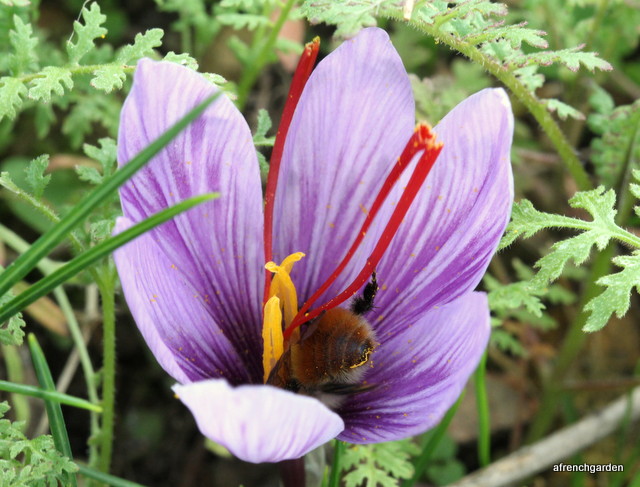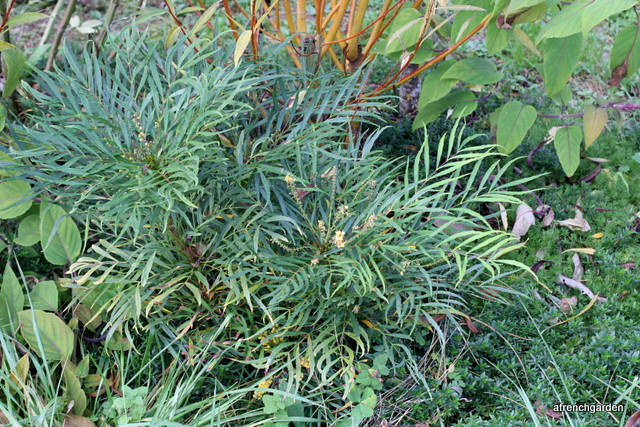The rain has come too late to have much effect on the summer vegetables but in the end the tomatoes yielded enough fruit for our needs for sauce and late salads. The butternut have yielded seventeen – not all very big but an improvement on the raised beds of last year.
At least now I feel confident enough to put in some brussel sprout plants.
Golden leaves carpet underneath the Liquidamber. The leaves are golden as the Liquidamber has not changed colour yet and these are dry leaves it has cast off in an effort to survive the lack of water.
The Ginkco is turning yellow and the parched leaves give the garden a true autumnal feel.
In the middle of the photograph is the struggling hydrangea “Saville Garden” that I planted in 2014. I really must find a better place for it. there is just not enough moisture for it in this spot and even too much shade for a hydrangea.
The Nerine Bowdenii fair better as they have bulbes that allow them to survive through the dry months.
I’m glad they provide nectar for the bumble bees, too.
I’m not sure where this bumble bee has been to get so covered with pollen, I think he needs to stop and have a good groom.
The Geranium Bronze (Cacyreus marshalli) is still coming to the asters. I misidentified this last week as a blue. In fact it is a native of Southern Africa but has been introduced with Pelargoniums for gardens. Pelargoniums are hugely popular in France to be used in pots outside houses in France. They do not survive the winter and so have to be re-bought the following year. Good business for the suppliers but I personally prefer the perennial geraniums which are very easy to grow in pots or the soil and can be divided and propagated year after year.
And also, (I am sure you have guessed,) the bees and pollinators can use the perennial geranium flowers but not the pelargoniums.
A bee that I have seen often on the asters is Epeolus fallax. It is a cuckoo bee; like the cuckoo bird it does not have its own nest but lays its eggs in the nest of other bees. The cuckoo bees are usually parasites of a limited number of species and not just any bees in general. The Epeolus are cleptoparasites of Colletes bees and I have found them at nesting sites of Ivy bees (https://beesinafrenchgarden.wordpress.com/2014/10/12/la-bourgade-revisited/).
However, the Ivy flowers are not open yet and the Ivy bees will not be building their nests yet. So perhaps they are targeting another Colletes bee at the moment.
I saw this tiny bee sitting on the leaf of our potted lemon tree. You can get an idea of how tiny it is as the photograph has made the leaf’s stomata visible. I was not absolutely sure it was a bee but the photograph allowed me to see the three simple eyes placed in a triangular pattern on the top of the bee’s head. It looks much more like a bee now, magnified larger than life-size.
The French marigolds (Tagetes patula) that I planted as companion plants in the vegetable garden are doing well now and are popular with the honey bees. In France they are called “Oeillets d’Inde” which roughly translated means Indian carnations! If you ignore the orange colour they do ressemble carnations.
I like to use flowers, like borage, on salads and cakes but I did not realise that French marigolds are edible too. their petals can be used to colour desserts like fruit salad and have been given the name of saffron of the poor. I have to look into this!
Temperatures have dropped considerably these past few days and it is hard to imagine that we were watching the sun set on the beach at Mescher-sur-Gironde a week ago. The beach is only a half hour drive from the house and we were able to enjoy an evening swim with temperatures of 34 degrees as the sun was setting.
I do not think that will be repeated until next year.




















